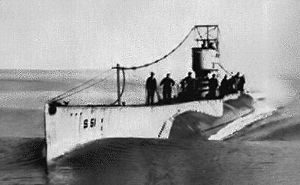USS S-51 (SS-162) was a fourth-group (S-48) S-class submarine of the United States Navy.
 USS S-51
| |
| History | |
|---|---|
| Name | USS S-51 |
| Builder | Lake Torpedo Boat Company |
| Laid down | 22 December 1919 |
| Launched | 20 August 1921 |
| Commissioned | 24 June 1922 |
| Stricken | 27 January 1930 |
| Fate |
|
| General characteristics | |
| Class and type | S-class submarine |
| Displacement |
|
| Length | 240 ft (73 m) |
| Beam | 21 ft 10 in (6.65 m) |
| Draft | 13 ft 6 in (4.11 m) |
| Speed | |
| Complement | 38 officers and men |
| Armament |
|
Her keel was laid down on 22 December 1919 by the Lake Torpedo Boat Company of Bridgeport, Connecticut. She was launched on 20 August 1921 sponsored by Mrs. R.J. Mills, and commissioned on 24 June 1922 with Lieutenant W. S. Haas in command.
Operations
The new submarine was based at New London, Connecticut on 1 July 1922 as a unit of Submarine Division 4 (SubDiv 4) and followed a normal peacetime training cycle, operating out of her home port with visits to Newport, Rhode Island, and Providence, Rhode Island. She departed from New York City on 4 January 1924 for the Panama Canal Zone to participate in winter fleet maneuvers off Panama and in the Caribbean Sea. During this cruise, she visited Trinidad, Guantanamo Bay, Culebra, and St. Thomas, Virgin Islands. After returning to New York City on 30 April, she resumed type training off Block Island and in New England coastal waters.
Sinking
On the night of 25 September 1925, S-51 was operating on the surface near Block Island, with her running lights on.[1] The merchant steamer City of Rome spotted a single white masthead light but were unable to determine its course, speed, or intentions. The ship altered her course away from the unknown light to give whatever it might be greater leeway. Meanwhile, S-51 spotted the ship's masthead and green sidelights, and held her course as she was required to do by the Rules of the Road then in effect. Shortly after altering course, City of Rome spotted the submarine's red sidelight and realized that they were on collision courses. She turned and backed her engines, but it was too late. Twenty-two minutes after first spotting the submarine's masthead light, the steamer rammed her at the position 41°14′30″N 71°16′16″W / 41.24167°N 71.27111°W.[2]
Only three of the 36 men in the submarine were able to abandon ship before she sank.
The courts found City of Rome at fault for not reducing her speed when in doubt as to the movement of S-51, and for not signaling her change of course. However, both the district court and the Circuit Court of Appeals found S-51 at fault for having improper lights.
The United States Navy argued that it was not practicable to have submarines of this class comply with the letter of the law, and that, as a special type of warship, S-51 was under no legal compulsion to do so. The court responded by saying if these statements were correct, then submarines "should confine their operation to waters not being traversed by other ships."
Salvage
S-51 was raised on 5 July 1926 by a team led by then-Lieutenant Commander (later Rear Admiral) Edward Ellsberg. The entire salvage operation was commanded by Captain (later Fleet Admiral) Ernest J. King. She was struck from the Naval Vessel Register on 27 January 1930 and sold for scrap on 23 June to the Borough Metal Company of Brooklyn, New York.[3]
See also
- The S-51 Accident Web site
- Ellsberg, Edward. "Report on Salvage Operations: Submarine S-51". Navy Department: United States Government Printing Office, 1927.
- _____. On the Bottom. New York: The Literary Guild of America, Inc, 1929. ISBN 0-9718303-0-4.
References
This article incorporates text from the public domain Dictionary of American Naval Fighting Ships. The entry can be found here.
- ^ "Submarine Casualties Booklet". U.S. Naval Submarine School. 1966. Retrieved 8 September 2009.
{{cite journal}}: Cite journal requires|journal=(help) - ^ New York Times, 27 September 1925, Section 1, pages 5–8.
- ^ "Famous Sub Makes Last Trip To The Junk Pile", October 1931, Popular Mechanics
External links
- On Eternal Patrol: USS S-51
- NavSource Online: Submarine Photo Archive S-51 (SS-162)
- "COURAGE!" Popular Mechanics, March 1933 – detailed article on salvage operation